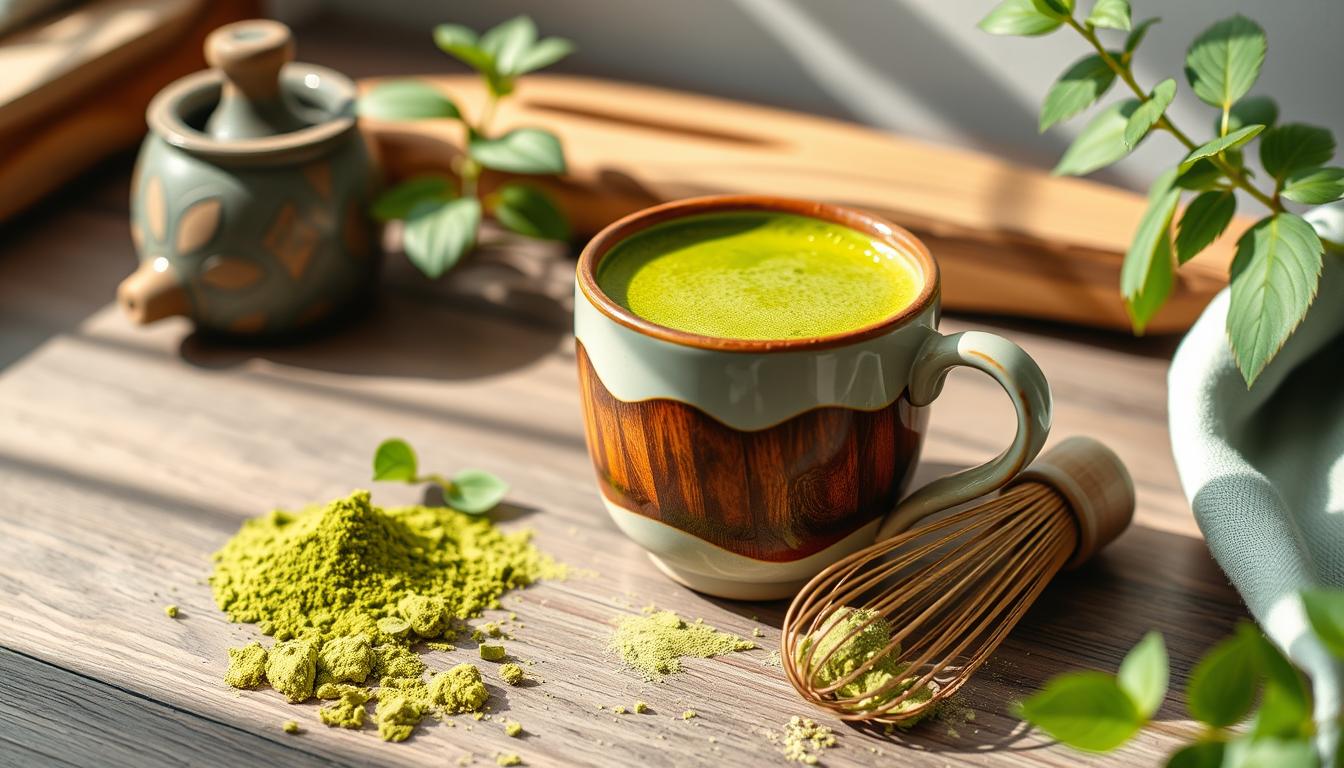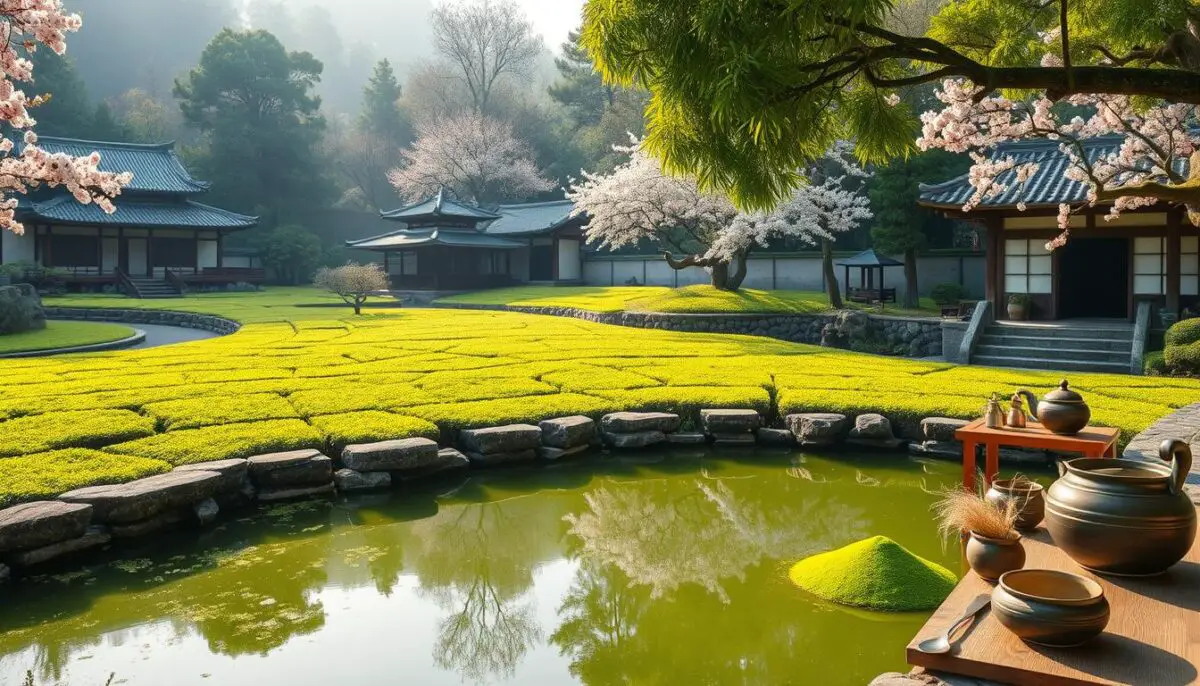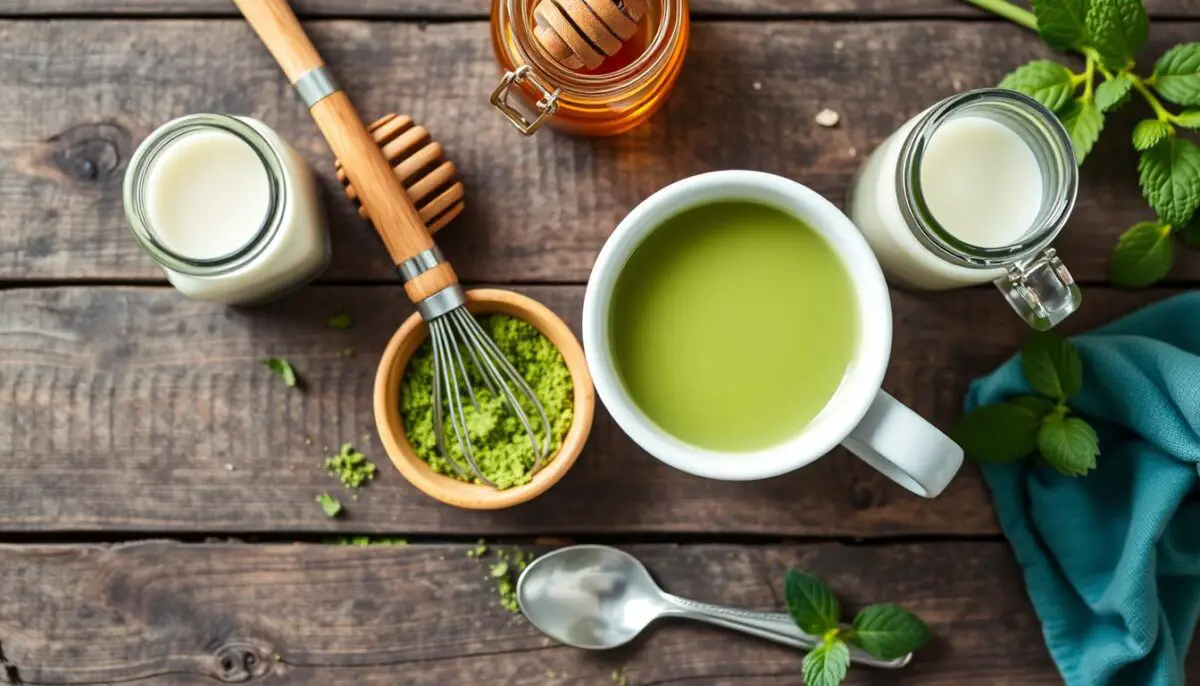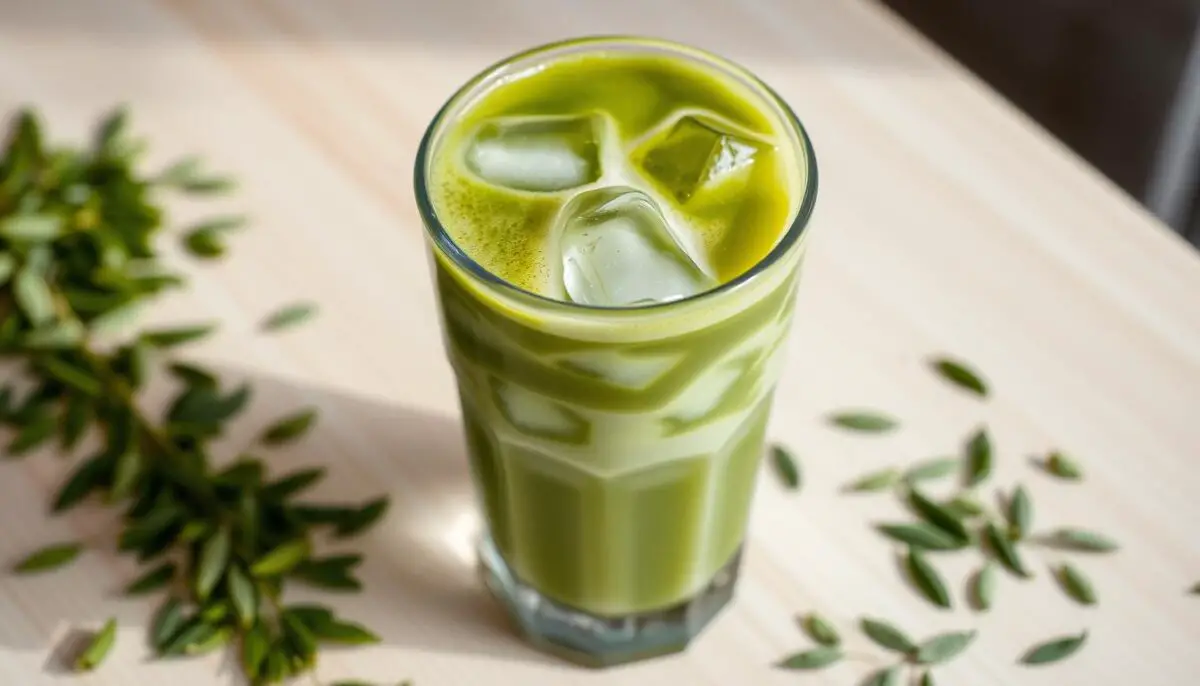Matcha latte has become very popular, and it’s easy to see why. This green drink is not only tasty but also packed with health benefits. It’s full of antioxidants and can even improve your brain function.
In this article, we’ll dive into the amazing benefits of matcha latte. We’ll also share a simple recipe to make it at home. This way, you can enjoy it whenever you want.
Key Takeaways
- Matcha latte offers various health benefits, including rich antioxidants.
- A homemade matcha latte recipe is easy to follow with just a few ingredients.
- This beverage can help boost metabolism and support weight management.
- Matcha latte enhances focus, making it a perfect drink for busy mornings.
- Choosing high-quality matcha powder is essential for the best taste and health outcomes.
Introduction to Matcha Latte
Matcha Latte is a creamy, vibrant drink made with matcha powder and steamed milk. It’s a twist on traditional green tea, loved by many. To understand what is Matcha Latte, you need to know its rich flavor and matcha’s special traits.
The benefits of Matcha make it popular. It’s tasty and full of health benefits. People love it for its antioxidants, which boost health. Knowing about Matcha Latte helps us see its value in a healthy diet.
Exploring Matcha reveals its unique qualities. It offers a delightful taste and health benefits, making it special.
What is Matcha?
Matcha is a special kind of green tea, full of history and tradition. Its history and how it’s grown make it stand out. This vibrant green drink is unlike any other.
History of Matcha
The origin of Matcha goes back to the 12th century in Japan. Buddhist monks brought it in, loving its calming effects during meditation. Over the years, Matcha tea history grew, becoming key in Japanese tea ceremonies. These ceremonies focus on mindfulness and the art of making tea.
The way tea leaves are shaded makes Matcha unique. This process boosts its flavor and color, unlike regular green tea.
Difference Between Matcha and Regular Green Tea
The main difference between Matcha and green tea is how they’re made. Regular green tea is steeped and then thrown away. Matcha, on the other hand, is ground into a fine powder from the whole leaf. This makes it more nutritious and caffeinated.
When you compare Matcha vs green tea, you see different tastes and health perks. The way Matcha is consumed lets you enjoy all its goodness.
| Feature | Matcha | Regular Green Tea |
|---|---|---|
| Cultivation | Shaded before harvest | Sunlight exposure |
| Processing | Whole leaf ground into powder | Leaves steeped, then discarded |
| Nutrient Concentration | Higher in antioxidants and caffeine | Lower levels of nutrients |
| Flavor Profile | Rich, creamy umami | Grassy, lighter taste |
Health Benefits of Matcha Latte
Adding a Matcha Latte to your daily routine offers many benefits. Matcha’s unique properties lead to several health advantages. These benefits make this green drink very important.
Antioxidant Properties
Matcha is full of antioxidants, like catechins. These fight oxidative stress and inflammation. This helps protect against chronic diseases, making Matcha Latte very beneficial.
Boosts Metabolism and Aids in Weight Loss
Matcha’s caffeine and catechins boost metabolism. They help burn fat during exercise. Drinking a Matcha Latte can help with weight loss, making it a favorite among health lovers.
Enhances Focus and Mental Clarity
Matcha improves focus and mental clarity. It contains L-theanine, which helps you stay alert but calm. This makes it a great choice for those who want clear thinking without caffeine’s jitters.
Supports Heart Health
Drinking matcha regularly can improve heart health. It can lower bad cholesterol and blood pressure. This makes Matcha a top choice for heart health.
How to Make a Matcha Latte at Home
Making a Matcha Latte at home is easy. You just need the right ingredients and a simple process. This way, you get a tasty drink and enjoy its health benefits. Here’s what you need and how to make it.
Ingredients Needed
- 2 teaspoons of high-quality matcha powder
- 1 cup of milk (dairy or non-dairy alternative)
- 1-2 teaspoons of sweetener (like honey or agave syrup, optional)
- 1/4 cup of hot water (not boiling)
Step-by-Step Instructions
Here’s how to make a Matcha Latte:
- Start by warming the water. It should be hot but not boiling, as boiling water can compromise the matcha flavor.
- In a bowl, whisk the matcha powder with the hot water until smooth. A bamboo whisk works best for this task, but a standard whisk is acceptable.
- In a separate saucepan, heat the milk over medium heat. If you prefer frothiness, consider using a frother or a blender.
- Once the milk is heated to your desired temperature, combine the matcha mixture with the milk.
- Add sweetener to taste, stirring it in thoroughly.
- Pour your Matcha Latte into a cup and enjoy the vibrant green latte you created.
With these ingredients and the recipe, you can make a great Matcha Latte at home. It’s just like the ones you find in cafes.
Choosing the Right Matcha Powder
Choosing the right matcha powder is key to enjoying its taste and health benefits. It’s important to know the different types of matcha. This knowledge helps in understanding the taste and how to use it.
The main types are culinary and ceremonial matcha. Each has its own role in cooking and tea ceremonies. Culinary matcha is great for cooking, while ceremonial matcha is for traditional Japanese tea ceremonies.
Types of Matcha Powder
Culinary matcha is used in cooking and baking. It has a milder flavor than ceremonial matcha but is just as healthy. Ceremonial matcha, being of higher quality, is perfect for tea ceremonies. It offers a richer flavor and vibrant color.
This type is best enjoyed on its own or with a little bit of something else. This way, you can fully appreciate its delicate taste.
Where to Buy High-Quality Matcha
Looking for the best places to buy Matcha is important. Specialty tea shops and online retailers like Matcha Konomi offer top brands. This makes it easy to compare and choose.
When buying matcha powder, always check the labels. Look for purity and organic certifications. This ensures you get the best quality matcha.
Variations of Matcha Latte
Exploring different Matcha Latte variations lets you tailor it to your taste. You can enjoy refreshing iced drinks or try dairy-free options. Each twist offers a unique taste experience.
Iced Matcha Latte Recipe
An iced Matcha Latte is great for hot days. It mixes matcha’s vibrant taste with cool ingredients. Start with a teaspoon of matcha powder and whisk it with hot water.
Pour it over ice in a glass. Add your favorite milk, like almond or oat, to finish it. This cold version is a refreshing twist for matcha lovers.
Matcha Latte with Alternative Milks
Using almond milk or other plant-based milks makes a dairy-free Matcha Latte. These milks add creaminess without lactose. They also enhance the flavor. Trying different milks lets you customize the drink to your liking.
Sweetening Your Matcha Latte
The right sweetener can make your Matcha Latte even better. Honey, agave nectar, and stevia are great choices. They add sweetness without hiding the matcha’s taste. Adjust the sweetness to your liking, enjoying a healthy yet indulgent drink.
| Variation | Main Ingredients | Notes |
|---|---|---|
| Iced Matcha Latte | Matcha powder, hot water, milk (almond, oat, etc.), ice | Refreshing on hot days |
| Matcha Latte with Almond Milk | Matcha powder, almond milk, honey (or sweetener) | Dairy-free option |
| Sweetening Options | Honey, agave nectar, stevia | Customizable sweetness levels |
Why You Should Incorporate Matcha Latte into Your Diet
Adding Matcha Latte to your daily routine has many benefits. This green drink is not just tasty but also packed with nutrients. It can boost your health and make your days more enjoyable.
Matcha is full of antioxidants, which are good for your skin and immune system. Drinking Matcha can also help you lose weight by speeding up your metabolism.
Matcha has caffeine and L-theanine, which give you energy without making you jittery. This makes it great for staying focused and calm, even when you’re busy.
Making a Matcha Latte is also a calming activity. It involves whisking the powder, heating the milk, and enjoying the drink. It’s a way to start your day or take a break with a special ritual.
Common Mistakes When Making Matcha Latte
Making a great Matcha Latte needs careful attention, like the right whisking and water temperature. Steer clear of common errors to improve the taste and feel of your drink. Focus on whisking tips and the best water temperature for a perfect cup every time.
Over-Whisking vs. Under-Whisking
Getting the right texture is all about whisking. Whisking too much can add air, making it frothy and not so good. Whisking too little can leave clumps, ruining the flavor and feel. Learn to whisk just right for a smooth, creamy Matcha Latte.
Using Incorrect Water Temperature
The water temperature is key to the taste of Matcha. It should be about 175°F. Water that’s too hot can make Matcha taste bitter. Water that’s too cold won’t mix well with the powder, missing out on flavor. Knowing the right temperature is key to a great Matcha Latte.
Conclusion
Matcha Latte is more than just a tasty drink. It’s full of antioxidants, boosts your metabolism, and improves your focus. It also helps keep your heart healthy. Adding Matcha Latte to your daily life can make you feel good and enjoy the moment.
Want to try making Matcha Latte at home? It’s easy and fun. You can make it hot, cold, or with different milks. Making your own Matcha Latte can become a special part of your day.
Matcha is not just healthy; it’s a way to enjoy life. It’s about taking time to appreciate something that’s good for you. Start your matcha journey and see how a Matcha Latte can make your day better.
FAQ
What are the health benefits of Matcha Latte?
Matcha Latte is packed with antioxidants, like catechins, which fight oxidative stress. It also boosts your metabolism and helps with weight loss. Plus, it improves mental clarity and supports heart health.
How do I make a homemade Matcha Latte?
To make a homemade Matcha Latte, you need high-quality matcha powder, steamed milk, water, and optional sweetener. First, whisk the matcha with warm water. Then, steam the milk. Lastly, mix them together for a creamy drink.
What is the difference between ceremonial and culinary matcha?
Ceremonial matcha is of higher quality, used in traditional tea ceremonies. Culinary matcha is used for cooking and baking. Ceremonial matcha is better for drinks, while culinary matcha is better for recipes.
Can I sweeten my Matcha Latte?
Yes, you can sweeten your Matcha Latte with honey, agave nectar, or stevia. Adjust the sweetness to your liking. Remember, matcha has health benefits.
What are some common mistakes when making a Matcha Latte?
Common mistakes include over-whisking, which creates bubbles, and under-whisking, which causes clumps. Also, using the wrong water temperature can affect the flavor. The ideal temperature is around 175°F.
Where can I buy high-quality matcha powder?
You can find high-quality matcha powder at specialty tea shops, organic food stores, and online at Matcha Konomi. Choose brands that are transparent about their sourcing and grading.
Can I make an iced Matcha Latte?
Yes, you can make an iced Matcha Latte. Prepare the matcha as usual, let it cool, then add ice and milk. It’s a refreshing drink for hot days.
What types of milk can be used in a Matcha Latte?
You can use different milks, like almond milk, oat milk, coconut milk, or dairy milk. Pick one that fits your dietary needs or preferences.




